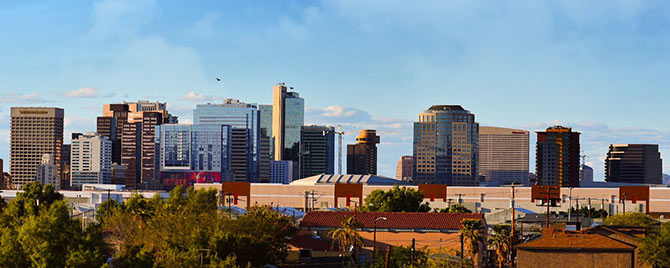Have you ever thought about how cash gets into your hands or to businesses? The gist is that Federal Reserve Banks ship cash into local economies and accept deposits from financial institutions that have too much currency on hand. It’s our job to ensure national and regional banks have currency that’s genuine and fit for commerce.
Cash can travel a long way
Back in the 1990s, Phoenix’s population was growing at a tremendous rate and, with it, demand for currency. At the time, armored vehicles were driving cash from the San Francisco Fed’s Los Angeles branch in California, over 600 miles of desert, to Arizona.
A few challenges became apparent to the Fed.
The risks of shipping large loads of money were high, as were associated costs. As a result, cash was remaining in circulation longer in Phoenix, so it was getting worn down faster. And the people of Phoenix were noticing that the quality of their Federal Reserve notes wasn’t great.
How could the Fed provide equitable service? Trying to keep up with increasing cash demand over a long-haul simply didn’t make sense.
The solution was to open the Phoenix Processing Center (PPC) in 2001 to better serve the cash needs of Phoenix and all of Arizona. It’s a decision that’s served everyone well. In 2017, Phoenix officially became the fifth largest city in the United States.
Automation does the heavy lifting
The PPC isn’t a branch of the Federal Reserve Bank of San Francisco in its own right. It’s a cash processing center. That’s it. And we’re proud of it.
Inside is one of the few fully-automated cash operations in the Federal Reserve System. Automated guided vehicles deliver currency between the automated, multi-tiered vault and the cash processing rooms.
Solar power generates energy
Phoenix basks in more sunshine than any other major metropolitan area in the U.S.—85% of our daylight hours. Fittingly, we became the first in the Federal Reserve System to incorporate energy from the sun into our daily operations when we installed a new solar-powered roof in 2016.

Our employees are warm, too
Almost all of our team members at the PPC work in Cash, Police Services, or Facilities. As a processing center, our pride stems from our awareness that we serve the community directly. We’ve built a close-knit group of colleagues who are high-performing and a lot of fun to work with. It’s a very open, family-like culture.
Because of the front-line nature of our work, we’re all about engaging face to face. We rely less on email, texting, and other digital communication and like to connect in person. You’ll find people with every job title swapping stories and contributing to an atmosphere that is warm, personable, and collaborative.
And we serve the Phoenix community
Our initial outreach work with the community began when we opened in 2001. At that time, efforts focused on making sure local police, fire, FBI, and other agencies were aware of us. Who we are. Our location. What we do. How to access our facility. That type of thing.
We also do a lot of purposeful outreach to let local businesses and community members know we are here and will help them keep our community safe and secure. Our “Coffee with a Cop” program, for example, gives local citizens the opportunity to ask questions, voice concerns, and get to know our PPC law enforcement officers.
We’re excited to expand and deepen the ways we serve our region with a formal community outreach program and will be getting out into the community even more in 2020. And, of course, we look forward to continuing our everyday work of ensuring the currency in Arizona is safe, secure, and sound.
Dawn Hennings is group vice president of Police Services at the Federal Reserve Bank of San Francisco and regional executive for the Phoenix Processing Center.
Roger Replogle is executive vice president, cash product manager, and Los Angeles branch regional executive at the Federal Reserve Bank of San Francisco.
You may also like:
The views expressed here do not necessarily reflect the views of the management of the Federal Reserve Bank of San Francisco or of the Board of Governors of the Federal Reserve System.
